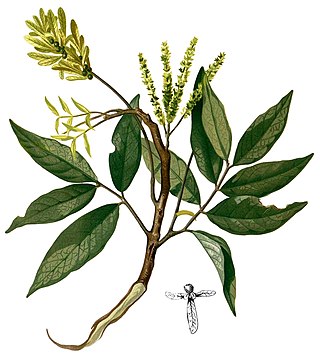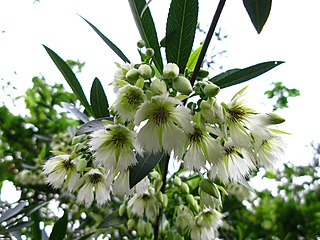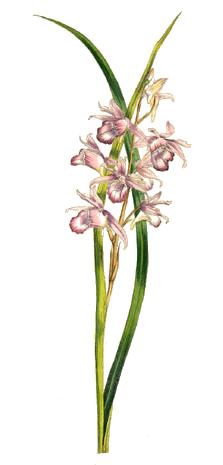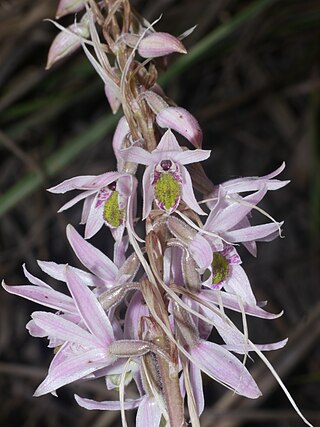
Engelhardia is a genus of trees in the family Juglandaceae, native to tropical Asia from northern India east to Taiwan, Indonesia and the Philippines. The genus name is commonly misspelled "Engelhardtia", a "correction" made by the original author Carl Ludwig Blume in 1829 and persistent until today, as it was thus entered in the Index Kewensis; the original spelling is Engelhardia.

Dasiphora fruticosa is a species of hardy deciduous flowering shrub in the family Rosaceae, native to the cool temperate and subarctic regions of the northern hemisphere, often growing at high altitudes in mountains. Dasiphora fruticosa is still widely referenced in the horticultural literature under its synonym Potentilla fruticosa. Common names include shrubby cinquefoil, golden hardhack, bush cinquefoil, shrubby five-finger, widdy, kuril tea and tundra rose.

Antidesma is a genus of tropical plant in the family Phyllanthaceae formally described by Linnaeus in 1753. It is native to tropical Africa, S + E + SE Asia, Australia, and various oceanic islands. The greatest diversity occurs in Southeast Asia.

Canarium is a genus of about 120 species of tropical and subtropical trees, in the family Burseraceae. They grow naturally across tropical Africa, south and southeast Asia, Indochina, Malesia, Australia and western Pacific Islands; including from southern Nigeria east to Madagascar, Mauritius, Sri Lanka and India; from Burma, Malaysia and Thailand through the Malay Peninsula and Vietnam to south China, Taiwan and the Philippines; through Borneo, Indonesia, Timor and New Guinea, through to the Solomon Islands, Vanuatu, New Caledonia, Fiji, Samoa, Tonga and Palau.

Elaeocarpus is a genus of nearly five hundred species of flowering plants in the family Elaeocarpaceae native to the Western Indian Ocean, Tropical and Subtropical Asia, and the Pacific. Plants in the genus Elaeocarpus are trees or shrubs with simple leaves, flowers with four or five petals usually, and usually blue fruit.

Arundina graminifolia is a species of orchid and the sole accepted species of the genus Arundina. This tropical Asiatic genus extends from Myanmar, India, Sri Lanka, Nepal, Thailand, Vietnam, the Ryukyu Islands, Malaysia, Singapore, China to Indonesia, the Philippines and New Guinea. It has become naturalized in Réunion, Fiji, French Polynesia, Micronesia, the West Indies, Costa Rica, Panama, Belize, and Hawaii. It is also called bamboo orchid.

Phaius, commonly known as swamp orchids or in Chinese as 鶴頂蘭屬/鹤顶兰属 , is a genus of forty-five species of flowering plants in the orchid family, Orchidaceae. They are evergreen, terrestrial herbs which form clumps with crowded, sometimes stem-like pseudobulbs, large, pleated leaves and relatively large, often colourful flowers. Species in this genus are found in the tropical parts of Africa, Asia, Southeast Asia, New Guinea, Australia, and various islands of the Pacific and Indian Oceans. One species is also naturalized in Hawaii, Florida, and the Caribbean.

Hemigraphis is a genus of plants in the family Acanthaceae, consisting of 34 species native to tropical Asia. Hemigraphis is similar to plants the genus Strobilanthes, with some species now placed there. Its native range is Nansei-shoto and from Indo-China to New Guinea.

Actinodaphne is an Asian genus of flowering plants in the laurel family (Lauraceae). It contains approximately 125 species of dioecious evergreen trees and shrubs.

Acriopsis, commonly known as chandelier orchids or 合萼兰属 is a genus of flowering plants in the family Orchidaceaes. Orchids in this genus are epiphytic herbs with spherical or cylindrical pseudobulbs, creeping, branched rhizomes, thin white roots, two or three leaves and many small flowers. The flowers are non-resupinate with the lateral sepals joined along their edges and have spreading petals and a three-lobed labellum. The column has projections that extend hood-like beyond the anther.

Trichoglottis, commonly known as cherub orchids or 毛舌兰属 , is a genus of flowering plants in the family Orchidaceae. Orchids in this genus are epiphytic plants with thick roots, relatively thick, fibrous stems and many large, thick, leathery leaves arranged in two ranks. The flowers are usually small and yellowish with light brown or purple markings. The flowers have broad sepals, narrower petals and a labellum which has three lobes and is often hairy. There are about 85 species distributed from tropical and subtropical Asia to the north-western Pacific. Most species grow in rainforest.

Pholidota, commonly known as rattlesnake orchids, is a genus of flowering plants from the orchid family, Orchidaceae. Plants in this genus are clump-forming epiphytes or lithophytes with pseudobulbs, each with a single large leaf and a large number of small, whitish flowers arranged in two ranks along a thin, wiry flowering stem that emerges from the top of the pseudobulb. There are about thirty five species native to areas from tropical and subtropical Asia to the southwestern Pacific.

Flemingia is a genus of plants in the family Fabaceae. It is native sub-Saharan Africa, Yemen, tropical Asia, and Australasia. In Asia the species are distributed in Bhutan, Burma, China, India; Indonesia, Laos, Malaysia, Nepal, Pakistan, Papua New Guinea, Philippines, Sri Lanka, Taiwan, Thailand and Vietnam. The genus was erected in 1812.

Hetaeria, commonly known as hairy jewel orchids, is a genus of about thirty species of flowering plants in the orchid family Orchidaceae. Plants in this genus are terrestrial herbs with a succulent rhizome and a loose rosette of leaves. Small, pale, hairy non-resupinate flowers are borne on a thin, hairy flowering stem. They are found in tropical Africa and Asia to New Guinea, Australia and some Pacific Islands.

Peristylus, sometimes commonly known as ogre orchids or bog orchids is a genus of flowering plants from the orchid family, Orchidaceae. It consists of over 100 known species found across much of eastern and southern Asia as well as in Australia and on many islands of the Indian and Pacific Oceans.

Sciaphila is a genus of mycoheterotrophic plants in the family Triuridaceae. These plants receive nutrition from fungi and neighboring trees and have less need for photosynthesis. It is widespread in tropical and subtropical regions, found in Africa, China, Japan, the Indian Subcontinent, Southeast Asia, Latin America and on various islands Pacific Islands. The most noteworthy feature of the genus is the number of the various flower parts 99.9 percent of Monocots are trimerous, but Sciaphila spp. can have eight or even ten parts in a whorl.

Gomphrena celosioides is a herbaceous perennial flowering plant belonging to the family Amaranthaceae and a cosmopolitan pioneer plant of disturbed areas, and one of 51 species in the genus Gomphrena.

Pachychila pubescens, commonly known as pink kunai orchid or as 粉口兰 , is a plant in the orchid family. It is native to areas from Asia through Southeast Asia to New Guinea and northern Australia. It is a deciduous, terrestrial herb with one or two grass-like leaves and up to ten dull pink, more or less drooping flowers. It grows in wet, grassy places in forests and woodlands.

Aporosa octandra is a species of plant in the family Phyllanthaceae found from Queensland and New Guinea to Indonesia, Zhōngguó/China and India. It is a highly variable plant with 4 named varieties. Its wood is used in construction and to make implements, its fruit is edible. The Karbi people of Assam use the plant for dyeing, textile colours have quite some significance in their culture.

Hewittia malabarica is a flowering plant in the monotypic genus HewittiaWight & Arn., belonging to the family Convolvulaceae and widespread throughout tropical Africa, Asia, and Polynesia. It is a climbing or prostrate perennial herb with slender stems and flowers that are pale yellow, cream, or white with a purple center, and large leaves that can be used as a cooked vegetable or used in folk medicine with the roots. The stems can be used to make ropes.




















